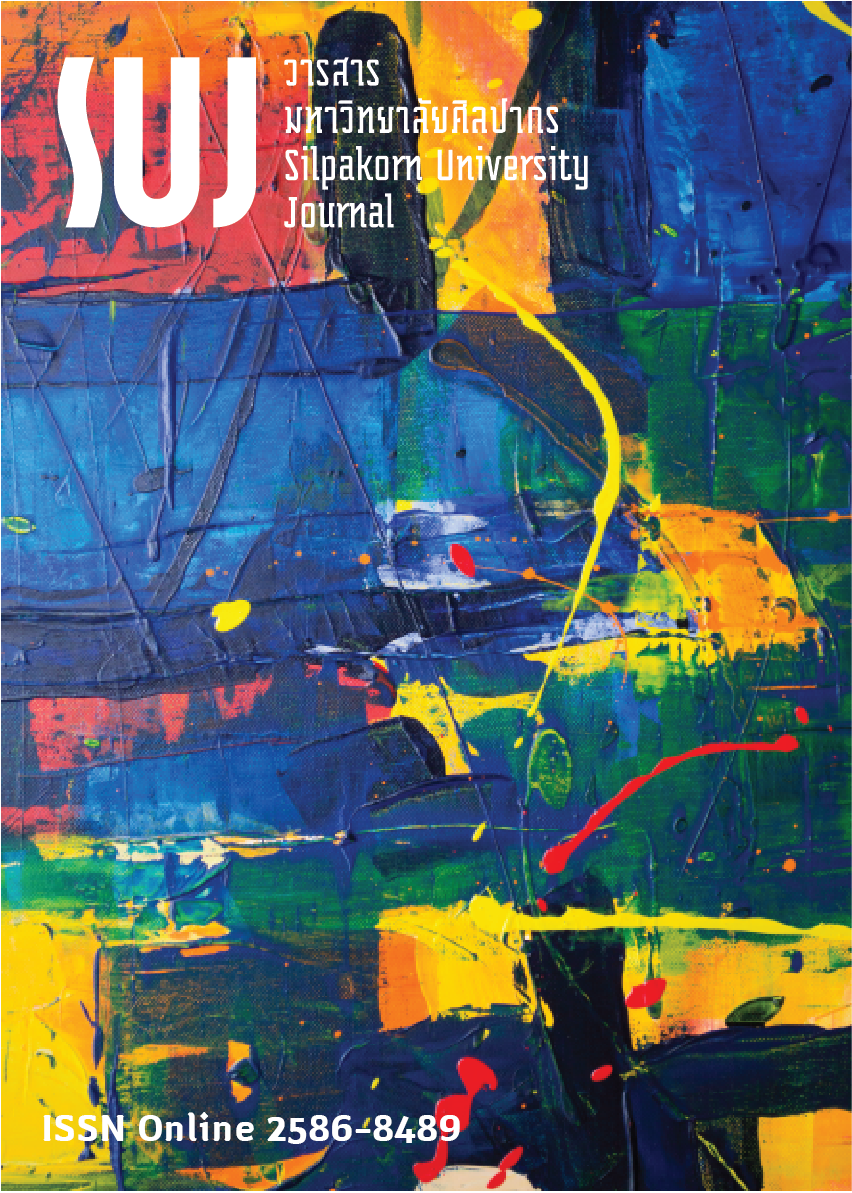ลูกเธอ ลูกฉัน ลูกเรา: รูปแบบครอบครัวแพ็ทช์เวิร์คในวรรณกรรมเด็กภาษาเยอรมัน (Your child, my child, our child: Patchwork family in German Children’s literature)
Main Article Content
Abstract
บทความนี้มีวัตถุประสงค์เพื่อนำเสนอรูปแบบความสัมพันธ์ของครอบครัวที่เรียกว่า Patchwork family ซึ่งหมายถึงครอบครัวที่มีลูกคนละพ่อคนละแม่อยู่ร่วมกัน ที่ปรากฎในวรรณกรรมเด็กภาษาเยอรมัน ปัจจุบันประเทศเยอรมนีมีหนังสือและวรรณกรรมเด็กที่เกี่ยวข้องกับหัวข้อดังกล่าวเป็นจำนวนมาก แต่เมื่อเปรียบเทียบกับวรรณกรรมเด็กที่เกี่ยวกับครอบครัวของไทยกลับพบว่าไม่มีเรื่องราวเกี่ยวกับรูปแบบครอบครัวแบบนี้เลย ผู้เขียนจึงมีความสนใจนำเสนอประเด็นเกี่ยวกับรูปแบบครอบครัว Patchwork family โดยตั้งคำถามว่า วรรณกรรมเด็กภาษาเยอรมันพยายามสร้างความเข้าใจและมุมมองเกี่ยวกับรูปแบบครอบครัวนี้ให้กับเด็กอย่างไร บทความนี้ใช้วิธีการวิจัยเชิงคุณภาพ (qualitative research) ในการนำเสนอความคิดเห็นเชิงวิชาการโดยศึกษาและวิเคราะห์ข้อมูล สถิติและยกตัวอย่างวรรณกรรมเด็กภาษาเยอรมันที่นำเสนอเรื่องราวเกี่ยวกับ Patchwork family จากการสำรวจเบื้องต้น ไม่พบหนังสือหรือวรรณกรรมเด็กภาษาไทยที่นำเสนอหัวข้อเกี่ยวกับ Patchwork family เลย บทความชิ้นนี้จึงสามารถตั้งคำถามต่อไปได้อีกว่าในสังคมไทยมีรูปแบบครอบครัวแบบนี้อยู่มากน้อยเพียงใด ได้รับการมองในแง่บวกหรือแง่ลบแตกต่างจากในสังคมเยอรมันอย่างไร และอาจเป็นข้อเสนอแนะในการแปลหนังสือหรือวรรณกรรมเด็กภาษาเยอรมันสมัยใหม่ในอนาคต
The purpose of this article was to examine the term “patchwork family”; a family of children with different fathers and mothers, which appears in German children’s literature. There is currently much children’s literature related to this topic in Germany. Compared to children’s literature related to Thai families, there was no story about this. The author was interested in examining the topic of a patchwork family. The question is: how was German children’s literature trying to illustrate the topic of a patchwork family for children? The study was a qualitative research to present an academic opinion. Statistics and theories related to this topic were used in this article. Based on the findings of the preliminary survey, there was no Thai children’s literature related to a patchwork family. This article might ask the questions: how many patchwork families are there in Thai society? How is it perceived positively or negatively differently in German society? It also might suggest that modern German children’s literature can be translated in the future.
Downloads
Article Details

This work is licensed under a Creative Commons Attribution-NonCommercial-NoDerivatives 4.0 International License.
References
Daly, M., & Wilson, M. (2001). The “Cinderella Effect”: Elevated Mistreatment of Stepchildren in Comparison to Those Living with Genetic Parents. Ontario: McMaster University Hamilton.
Friedman, M. M. (1986). Family Nursing: Theory and Assessment (2nd ed.). New York: Appleton-Century Crofs.
Hurrelmann, B. (1992). Aktuelle Kinder- und Jugendliteratur. In Praxis Deutsch 19, (pp. 9-18). Seelze: Velber.
Komchadluek. (2019). Divorce Statistics in Thailand (สถิติของกรมการปกครองกระทรวงมหาดไทยในปี 2560). [Online]. Retrieved February 22, 2020 from https://www.komchadluek.net/news/regional/382372
Maxeiner, A., & Kuhl, A. (2018). Alles Familie. Leipzig: Klett Kinderbuch.
Müller, E. (1986). Das Bild der Frau im Märchen. Analysen und erzieherische Betrachtungen. München: Profil-Verlag.
Oxford Dictionaries. (2020). Walt Disney. [Online]. Retrieved February 14, 2020 from https://www.lexico.com/definition/disney,_walt
Pilecky, E. (2006). Patchworkfamilie. Nicht nur “Flickwerk” sondern eine neue Chance für die Zukunft. Unpublished seminar paper, St. Pölten University of Applied Sciences, Sankt Pölten, Austria.
Radenacker, A. (2012). Stief- und Patchworkfamilien in Deutschland. In Monitor Familienforschung (Ed.), Beiträge aus Forschung, Statistik und Familienpolitik, (pp. 5-13). Berlin: Federal Ministry for Family Affairs, Senior Citizens, Women and Youth.
Ramkamhaeng University Library’s webmaster. (2012). Jacob Grimm & Wilhelm Grimm. [Online]. Retrieved February 22, 2020 from https://www.lib.ru.ac.th/miscell2/?p=1637
Schneider, N. F. (2013). Familie-Zwischen traditioneller Institution und individuell gestalteter Lebensform. In Stefan Hradil. Deutsche Verhältnisse. Eine Sozialkunde, (pp. 94-120). Frankfurt am Main: Campus. [Online]. Retrieved March 10, 2020 from https://www.bpb.de/politik/grundfragen/deutsche-verhaeltnisse-eine-sozialkunde/138016/familie
Watcharasin, Jintana. (2007). Advanced Family Nursing Theory (ทฤษฎีการพยาบาลครอบครัวขั้นสูง). Chonburi: Faculty of nursing. Burapha University.
Zacharias-Hellwig, J. (2018). Das kleine Kunterbunt. Eine Geschichte über Patchworkfamilien und Bonuseltern. Langenargen: MTM-Verlag GbR.


